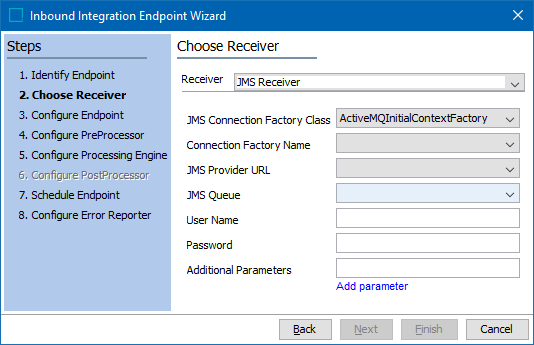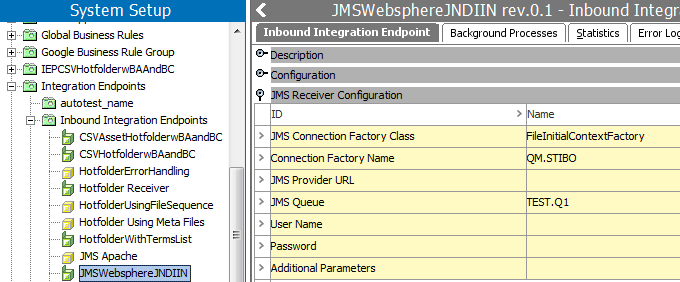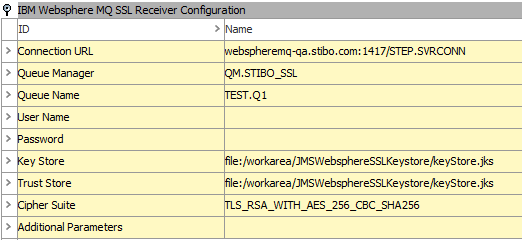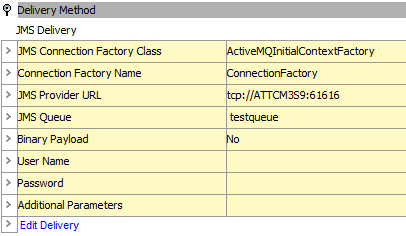The available options for the Java Message Service (JMS) receiver are system dependent. By default, the JMS Receiver option lets you consume and dequeue messages (instead of files) on queues defined below. Supported formats include STEPXML, Generic XML, CSV (text messages). JMS is the preferred option where compatible enterprise middleware is available and there is a need for time-critical incremental updates from external systems.
The Dynamic JMS Receiver (here) allows customers to supply the vendor-specific JMS libraries and JNDI configuration.
If additional JME support is required, contact your Stibo Systems account manager for customizations.
Prerequisites
Changes to the properties file, outlined below, are implemented when the server is restarted.
- Prior to configuration, clicking the JMS Connection Factory Name dropdown parameter displays the required property name. Provide a selection for the dropdown parameter via the sharedconfig.properties file on the STEP application server using the case-sensitive JMSConnectionFactoryName property. For example, two factory names are displayed with the following property setting:
JMSConnectionFactoryName=1=ConnectionFactory1,2=ConnectionFactory2
- Prior to configuration, clicking the JMS Provider URL dropdown parameter displays the required property name. Provide a selection for the dropdown parameter via the sharedconfig.properties file on the STEP application server using the case-sensitive JMSProviderURL property. For example, a single URL is displayed with the following property setting:
JMSProviderURL=1=tcp://[IP address]:[Port, ActiveMQ default is 61616]
- Prior to configuration, clicking the JMS Queue dropdown parameter displays the required property name. Provide a selection for the dropdown parameter via the sharedconfig.properties file on the STEP application server using the case-sensitive JMSQueue property.
JMSQueue=1=[Queue]
Configuration
After completing the prerequisite steps, edit the receiver of the IIEP. Use the following parameters to configure the IIEP. For information on a parameter, hover over the parameter field to display help text.

- For Receiver, choose JMS Receiver.
- For JMS Connection Factory Class, select one of the available JMS connection factory classes.
- ActiveMQInitialContextFactory: Allows set up of a JMS receiver connecting to Apache ActiveMQ. For information, search the web.
- FileInitialContextFactory: Enables setting up JMS WebSphere Inbound and Outbound Integration Endpoints which reference a binding file (created from JMS WebSphere Client software). The binding file is a configuration file which includes all details of how STEP should interact with JMS WebSphere. For information about JMS WebSphere Client Software, search the web.
Note: WMQInitialContextFactory is no longer supported, use FileInitialContextFactory instead.
- For Connection Factory Name, select a connection factory name in the list.
- For JMS Provider URL, select a JMS URL in the list.
- For JMS Queue, select the JMS Queue to be used on Apache ActiveMQ or WebSphere MQ.
- For User Name and Password, if required to log onto the JMS provider, enter a user name and a password.
- For Additional Parameters, if required, click the Add parameter link, then enter the Key and Value pairs. For possible keys and values, consult the manual for IBM WebSphere MQ.
- Click the Next button to continue with the Configure Endpoint step (here), or the Finish button to close the wizard.
Configuration Examples
The following images demonstrate the parameters and setup for a variety of JMS Receivers.
FileInitialContextFactory JMS Receiver

JMS WebSphere Delivery Using SSL

Apache ActiveMQ JMS Receiver
